Analyzing Descriptive Statistics in Business Analytics: Techniques
VerifiedAdded on 2020/03/23
|8
|1188
|122
Homework Assignment
AI Summary
This assignment focuses on the significance of descriptive analysis within the realm of business analytics. It systematically breaks down the core techniques used in descriptive analysis, categorizing them into measures of central tendencies (mean, median, mode) and measures of dispersion (range, variance, standard deviation). The assignment provides detailed explanations for each technique, outlining their purpose, functionality, assumptions, and methods of validation, along with practical sample use cases. Furthermore, it explores measures of position, including Z-scores, percentiles, quartiles, and interquartile range, offering similar insights into their application. The paper references several key academic sources to support the presented concepts and methodologies. This analysis provides a comprehensive overview of descriptive statistics within the business context.
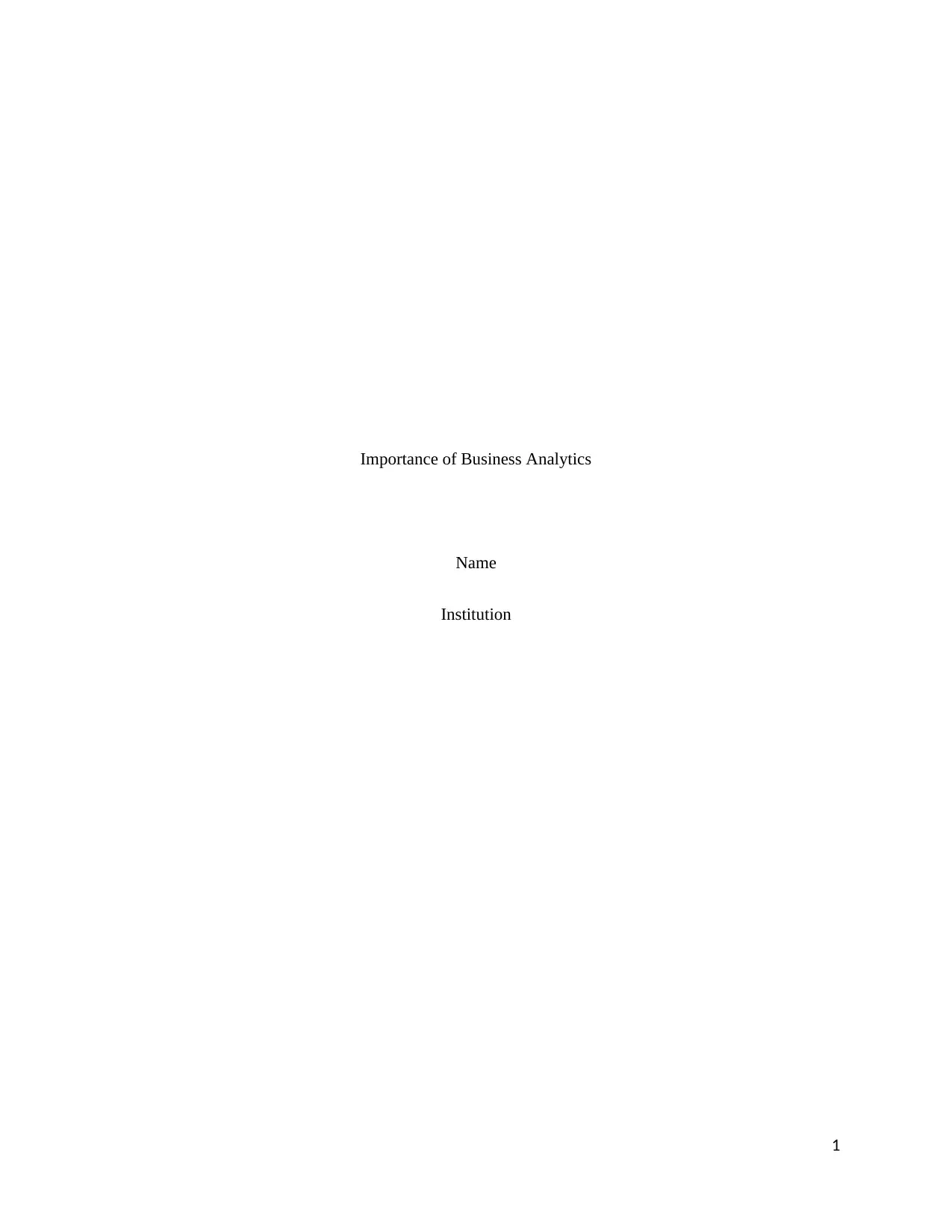
Importance of Business Analytics
Name
Institution
1
Name
Institution
1
Paraphrase This Document
Need a fresh take? Get an instant paraphrase of this document with our AI Paraphraser
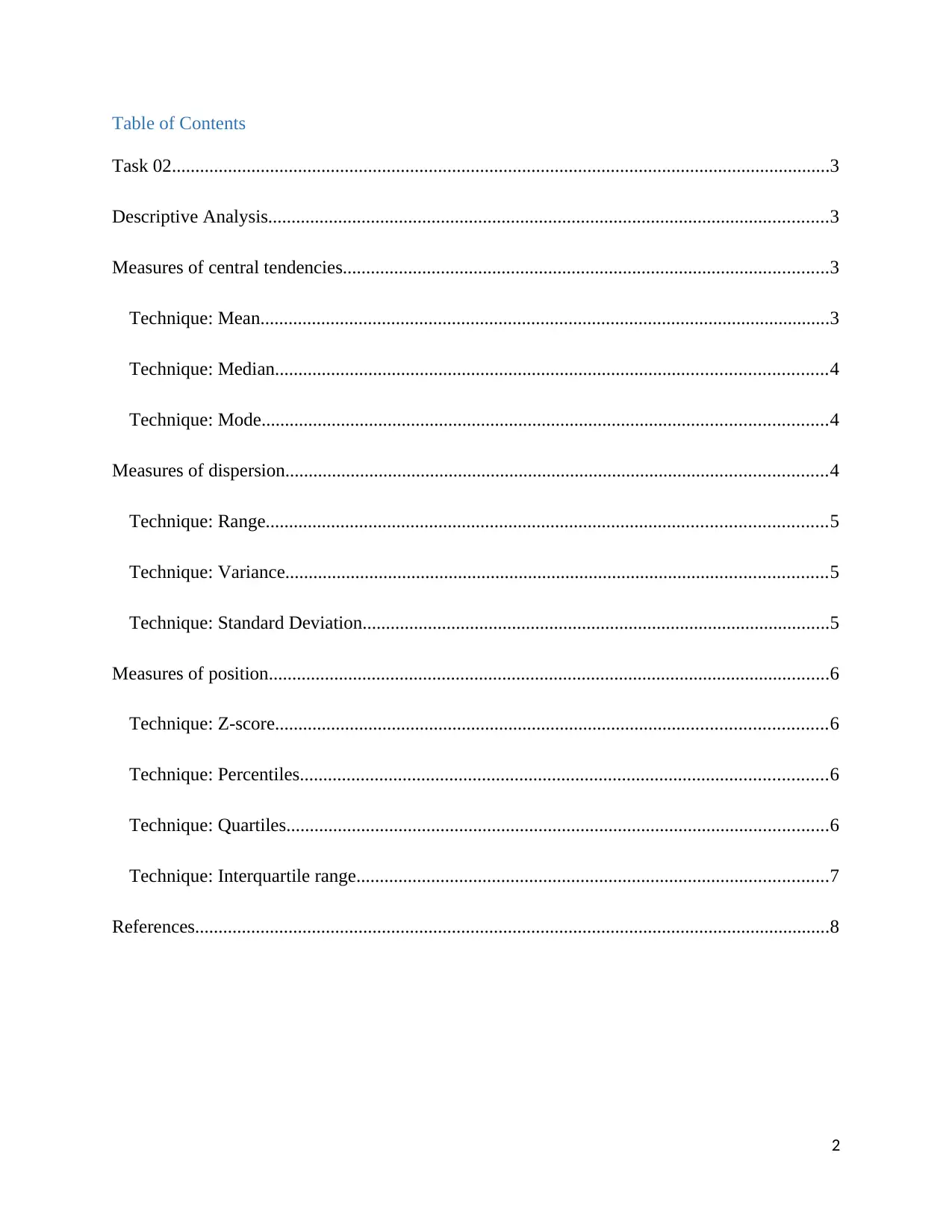
Table of Contents
Task 02.............................................................................................................................................3
Descriptive Analysis........................................................................................................................3
Measures of central tendencies........................................................................................................3
Technique: Mean..........................................................................................................................3
Technique: Median......................................................................................................................4
Technique: Mode.........................................................................................................................4
Measures of dispersion....................................................................................................................4
Technique: Range........................................................................................................................5
Technique: Variance....................................................................................................................5
Technique: Standard Deviation....................................................................................................5
Measures of position........................................................................................................................6
Technique: Z-score......................................................................................................................6
Technique: Percentiles.................................................................................................................6
Technique: Quartiles....................................................................................................................6
Technique: Interquartile range.....................................................................................................7
References........................................................................................................................................8
2
Task 02.............................................................................................................................................3
Descriptive Analysis........................................................................................................................3
Measures of central tendencies........................................................................................................3
Technique: Mean..........................................................................................................................3
Technique: Median......................................................................................................................4
Technique: Mode.........................................................................................................................4
Measures of dispersion....................................................................................................................4
Technique: Range........................................................................................................................5
Technique: Variance....................................................................................................................5
Technique: Standard Deviation....................................................................................................5
Measures of position........................................................................................................................6
Technique: Z-score......................................................................................................................6
Technique: Percentiles.................................................................................................................6
Technique: Quartiles....................................................................................................................6
Technique: Interquartile range.....................................................................................................7
References........................................................................................................................................8
2
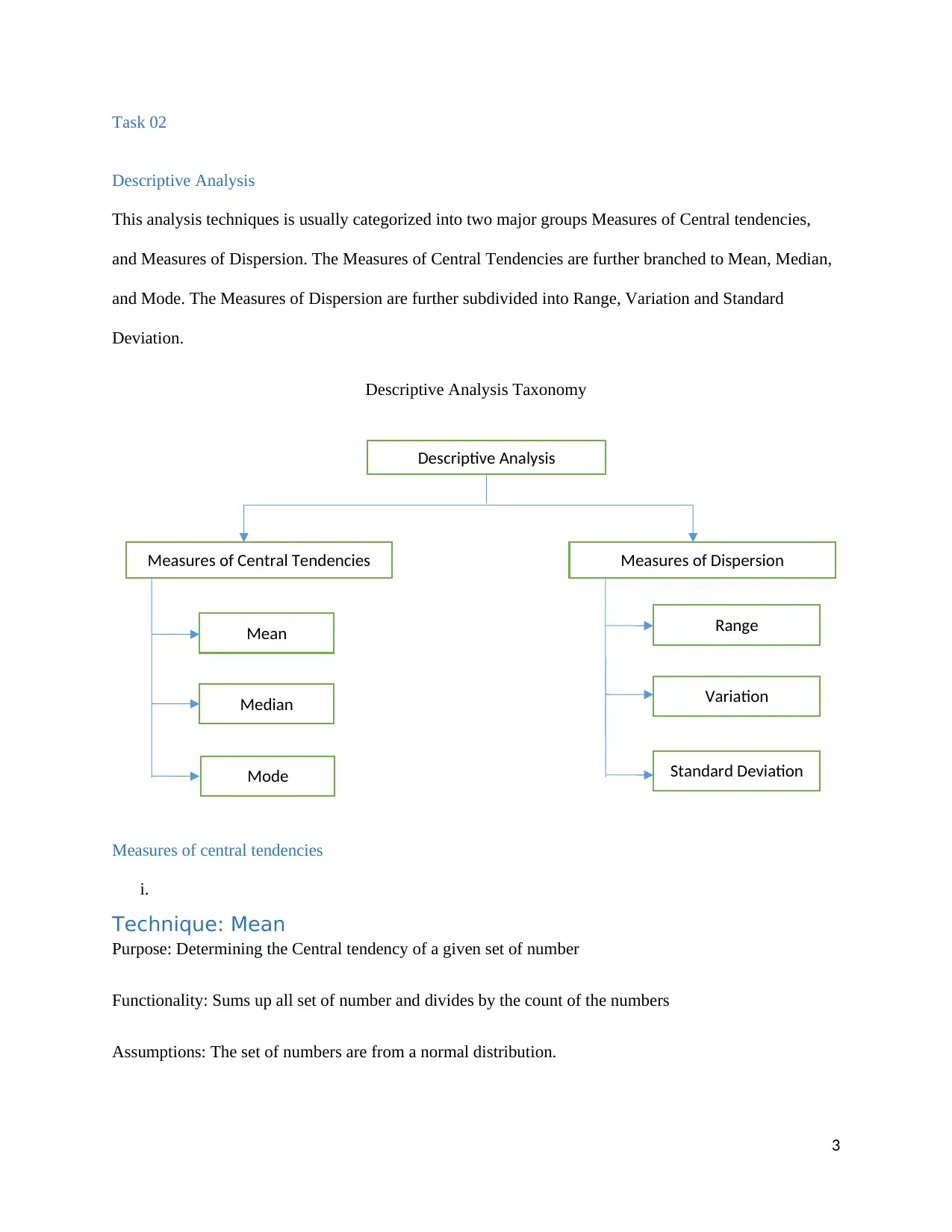
Task 02
Descriptive Analysis
This analysis techniques is usually categorized into two major groups Measures of Central tendencies,
and Measures of Dispersion. The Measures of Central Tendencies are further branched to Mean, Median,
and Mode. The Measures of Dispersion are further subdivided into Range, Variation and Standard
Deviation.
Descriptive Analysis Taxonomy
Measures of central tendencies
i.
Technique: Mean
Purpose: Determining the Central tendency of a given set of number
Functionality: Sums up all set of number and divides by the count of the numbers
Assumptions: The set of numbers are from a normal distribution.
3
Descriptive Analysis
Measures of Central Tendencies Measures of Dispersion
Mean
Median
Mode
Range
Variation
Standard Deviation
Descriptive Analysis
This analysis techniques is usually categorized into two major groups Measures of Central tendencies,
and Measures of Dispersion. The Measures of Central Tendencies are further branched to Mean, Median,
and Mode. The Measures of Dispersion are further subdivided into Range, Variation and Standard
Deviation.
Descriptive Analysis Taxonomy
Measures of central tendencies
i.
Technique: Mean
Purpose: Determining the Central tendency of a given set of number
Functionality: Sums up all set of number and divides by the count of the numbers
Assumptions: The set of numbers are from a normal distribution.
3
Descriptive Analysis
Measures of Central Tendencies Measures of Dispersion
Mean
Median
Mode
Range
Variation
Standard Deviation
⊘ This is a preview!⊘
Do you want full access?
Subscribe today to unlock all pages.

Trusted by 1+ million students worldwide
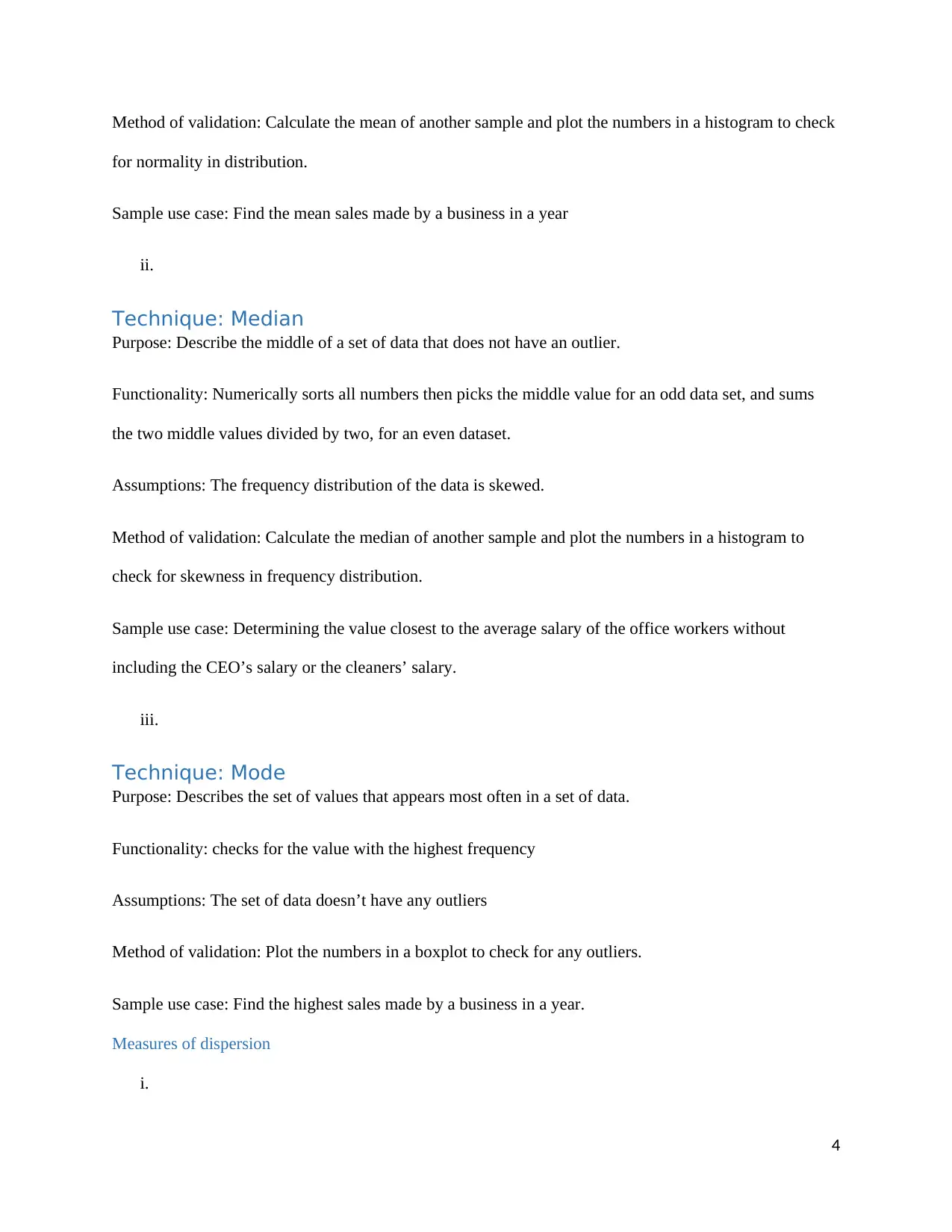
Method of validation: Calculate the mean of another sample and plot the numbers in a histogram to check
for normality in distribution.
Sample use case: Find the mean sales made by a business in a year
ii.
Technique: Median
Purpose: Describe the middle of a set of data that does not have an outlier.
Functionality: Numerically sorts all numbers then picks the middle value for an odd data set, and sums
the two middle values divided by two, for an even dataset.
Assumptions: The frequency distribution of the data is skewed.
Method of validation: Calculate the median of another sample and plot the numbers in a histogram to
check for skewness in frequency distribution.
Sample use case: Determining the value closest to the average salary of the office workers without
including the CEO’s salary or the cleaners’ salary.
iii.
Technique: Mode
Purpose: Describes the set of values that appears most often in a set of data.
Functionality: checks for the value with the highest frequency
Assumptions: The set of data doesn’t have any outliers
Method of validation: Plot the numbers in a boxplot to check for any outliers.
Sample use case: Find the highest sales made by a business in a year.
Measures of dispersion
i.
4
for normality in distribution.
Sample use case: Find the mean sales made by a business in a year
ii.
Technique: Median
Purpose: Describe the middle of a set of data that does not have an outlier.
Functionality: Numerically sorts all numbers then picks the middle value for an odd data set, and sums
the two middle values divided by two, for an even dataset.
Assumptions: The frequency distribution of the data is skewed.
Method of validation: Calculate the median of another sample and plot the numbers in a histogram to
check for skewness in frequency distribution.
Sample use case: Determining the value closest to the average salary of the office workers without
including the CEO’s salary or the cleaners’ salary.
iii.
Technique: Mode
Purpose: Describes the set of values that appears most often in a set of data.
Functionality: checks for the value with the highest frequency
Assumptions: The set of data doesn’t have any outliers
Method of validation: Plot the numbers in a boxplot to check for any outliers.
Sample use case: Find the highest sales made by a business in a year.
Measures of dispersion
i.
4
Paraphrase This Document
Need a fresh take? Get an instant paraphrase of this document with our AI Paraphraser
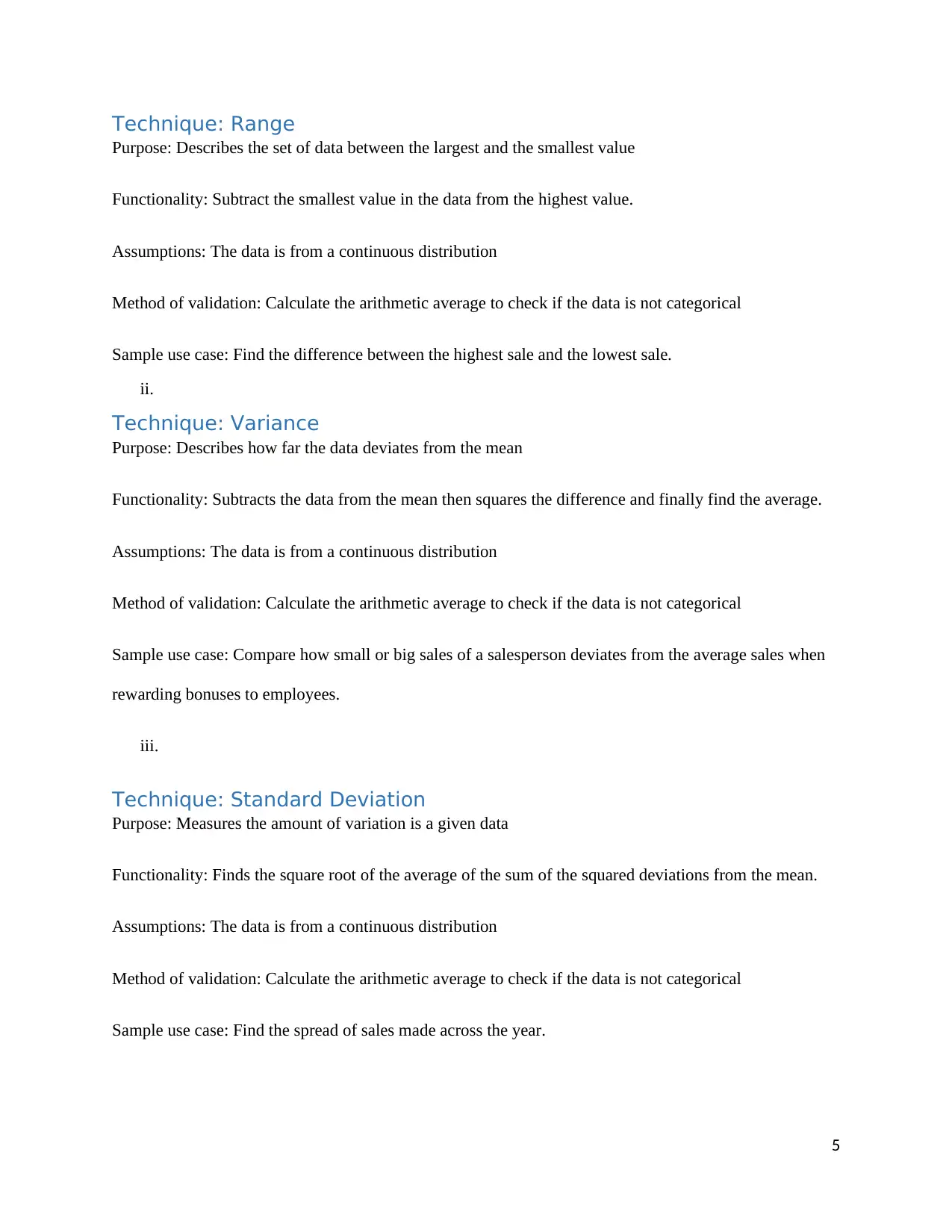
Technique: Range
Purpose: Describes the set of data between the largest and the smallest value
Functionality: Subtract the smallest value in the data from the highest value.
Assumptions: The data is from a continuous distribution
Method of validation: Calculate the arithmetic average to check if the data is not categorical
Sample use case: Find the difference between the highest sale and the lowest sale.
ii.
Technique: Variance
Purpose: Describes how far the data deviates from the mean
Functionality: Subtracts the data from the mean then squares the difference and finally find the average.
Assumptions: The data is from a continuous distribution
Method of validation: Calculate the arithmetic average to check if the data is not categorical
Sample use case: Compare how small or big sales of a salesperson deviates from the average sales when
rewarding bonuses to employees.
iii.
Technique: Standard Deviation
Purpose: Measures the amount of variation is a given data
Functionality: Finds the square root of the average of the sum of the squared deviations from the mean.
Assumptions: The data is from a continuous distribution
Method of validation: Calculate the arithmetic average to check if the data is not categorical
Sample use case: Find the spread of sales made across the year.
5
Purpose: Describes the set of data between the largest and the smallest value
Functionality: Subtract the smallest value in the data from the highest value.
Assumptions: The data is from a continuous distribution
Method of validation: Calculate the arithmetic average to check if the data is not categorical
Sample use case: Find the difference between the highest sale and the lowest sale.
ii.
Technique: Variance
Purpose: Describes how far the data deviates from the mean
Functionality: Subtracts the data from the mean then squares the difference and finally find the average.
Assumptions: The data is from a continuous distribution
Method of validation: Calculate the arithmetic average to check if the data is not categorical
Sample use case: Compare how small or big sales of a salesperson deviates from the average sales when
rewarding bonuses to employees.
iii.
Technique: Standard Deviation
Purpose: Measures the amount of variation is a given data
Functionality: Finds the square root of the average of the sum of the squared deviations from the mean.
Assumptions: The data is from a continuous distribution
Method of validation: Calculate the arithmetic average to check if the data is not categorical
Sample use case: Find the spread of sales made across the year.
5
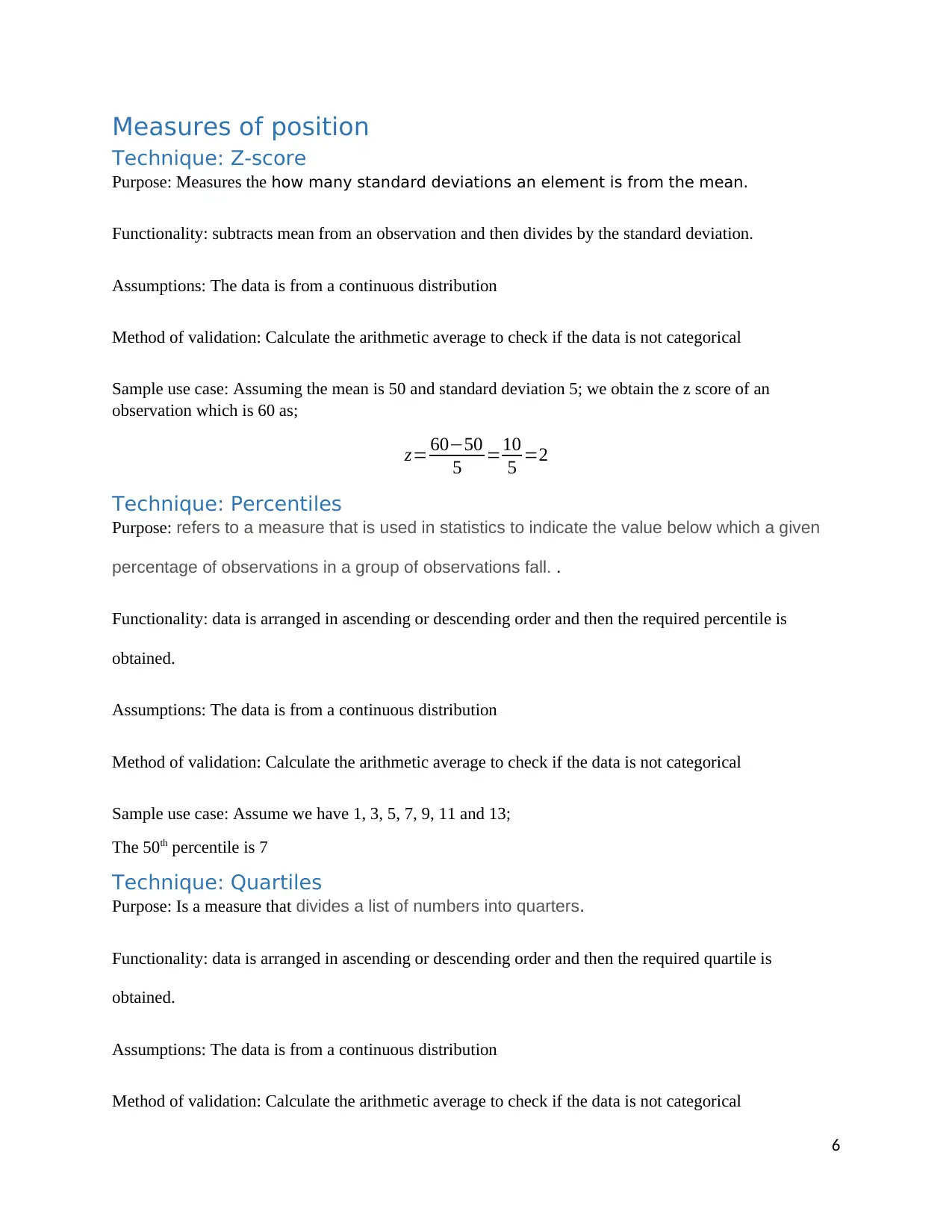
Measures of position
Technique: Z-score
Purpose: Measures the how many standard deviations an element is from the mean.
Functionality: subtracts mean from an observation and then divides by the standard deviation.
Assumptions: The data is from a continuous distribution
Method of validation: Calculate the arithmetic average to check if the data is not categorical
Sample use case: Assuming the mean is 50 and standard deviation 5; we obtain the z score of an
observation which is 60 as;
z= 60−50
5 =10
5 =2
Technique: Percentiles
Purpose: refers to a measure that is used in statistics to indicate the value below which a given
percentage of observations in a group of observations fall. .
Functionality: data is arranged in ascending or descending order and then the required percentile is
obtained.
Assumptions: The data is from a continuous distribution
Method of validation: Calculate the arithmetic average to check if the data is not categorical
Sample use case: Assume we have 1, 3, 5, 7, 9, 11 and 13;
The 50th percentile is 7
Technique: Quartiles
Purpose: Is a measure that divides a list of numbers into quarters.
Functionality: data is arranged in ascending or descending order and then the required quartile is
obtained.
Assumptions: The data is from a continuous distribution
Method of validation: Calculate the arithmetic average to check if the data is not categorical
6
Technique: Z-score
Purpose: Measures the how many standard deviations an element is from the mean.
Functionality: subtracts mean from an observation and then divides by the standard deviation.
Assumptions: The data is from a continuous distribution
Method of validation: Calculate the arithmetic average to check if the data is not categorical
Sample use case: Assuming the mean is 50 and standard deviation 5; we obtain the z score of an
observation which is 60 as;
z= 60−50
5 =10
5 =2
Technique: Percentiles
Purpose: refers to a measure that is used in statistics to indicate the value below which a given
percentage of observations in a group of observations fall. .
Functionality: data is arranged in ascending or descending order and then the required percentile is
obtained.
Assumptions: The data is from a continuous distribution
Method of validation: Calculate the arithmetic average to check if the data is not categorical
Sample use case: Assume we have 1, 3, 5, 7, 9, 11 and 13;
The 50th percentile is 7
Technique: Quartiles
Purpose: Is a measure that divides a list of numbers into quarters.
Functionality: data is arranged in ascending or descending order and then the required quartile is
obtained.
Assumptions: The data is from a continuous distribution
Method of validation: Calculate the arithmetic average to check if the data is not categorical
6
⊘ This is a preview!⊘
Do you want full access?
Subscribe today to unlock all pages.

Trusted by 1+ million students worldwide
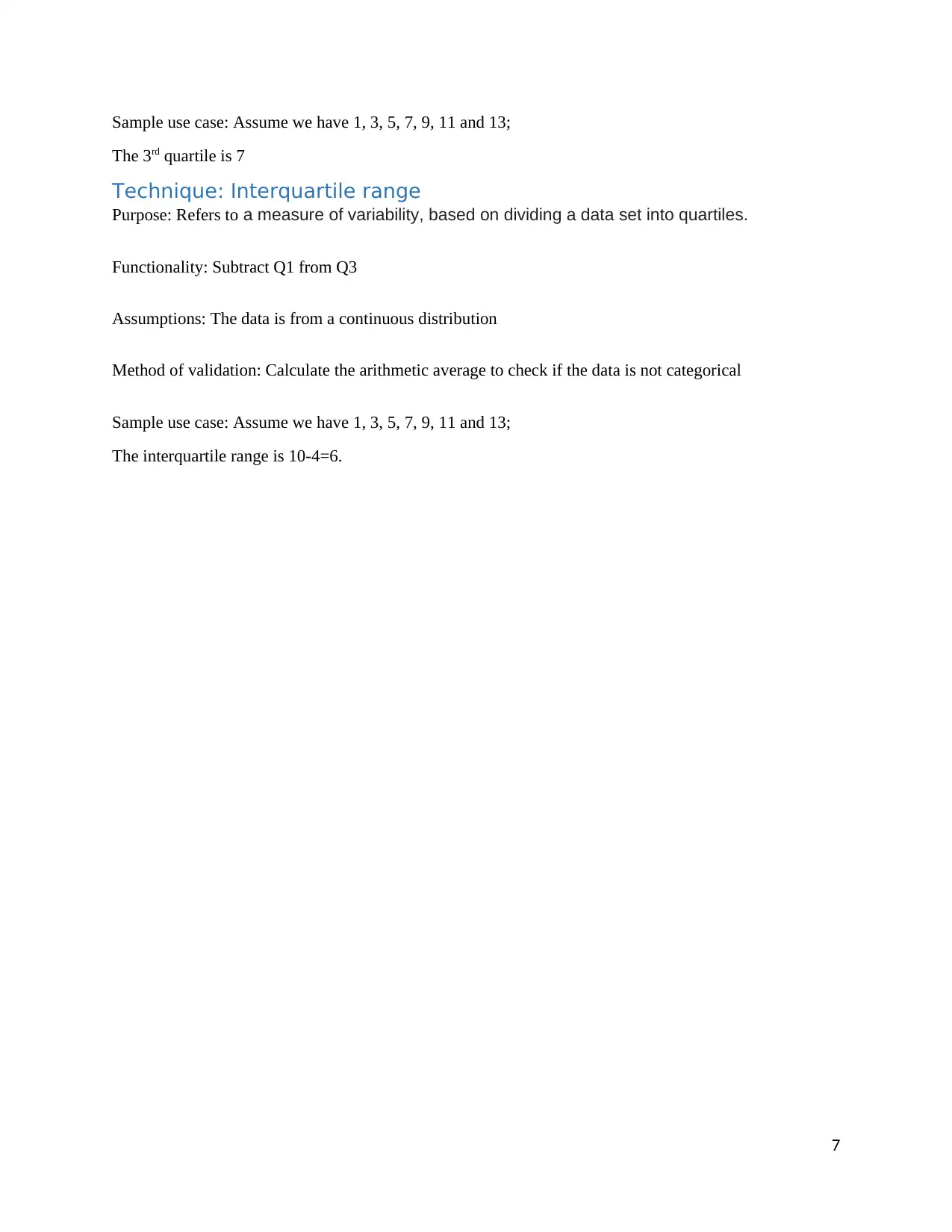
Sample use case: Assume we have 1, 3, 5, 7, 9, 11 and 13;
The 3rd quartile is 7
Technique: Interquartile range
Purpose: Refers to a measure of variability, based on dividing a data set into quartiles.
Functionality: Subtract Q1 from Q3
Assumptions: The data is from a continuous distribution
Method of validation: Calculate the arithmetic average to check if the data is not categorical
Sample use case: Assume we have 1, 3, 5, 7, 9, 11 and 13;
The interquartile range is 10-4=6.
7
The 3rd quartile is 7
Technique: Interquartile range
Purpose: Refers to a measure of variability, based on dividing a data set into quartiles.
Functionality: Subtract Q1 from Q3
Assumptions: The data is from a continuous distribution
Method of validation: Calculate the arithmetic average to check if the data is not categorical
Sample use case: Assume we have 1, 3, 5, 7, 9, 11 and 13;
The interquartile range is 10-4=6.
7
Paraphrase This Document
Need a fresh take? Get an instant paraphrase of this document with our AI Paraphraser
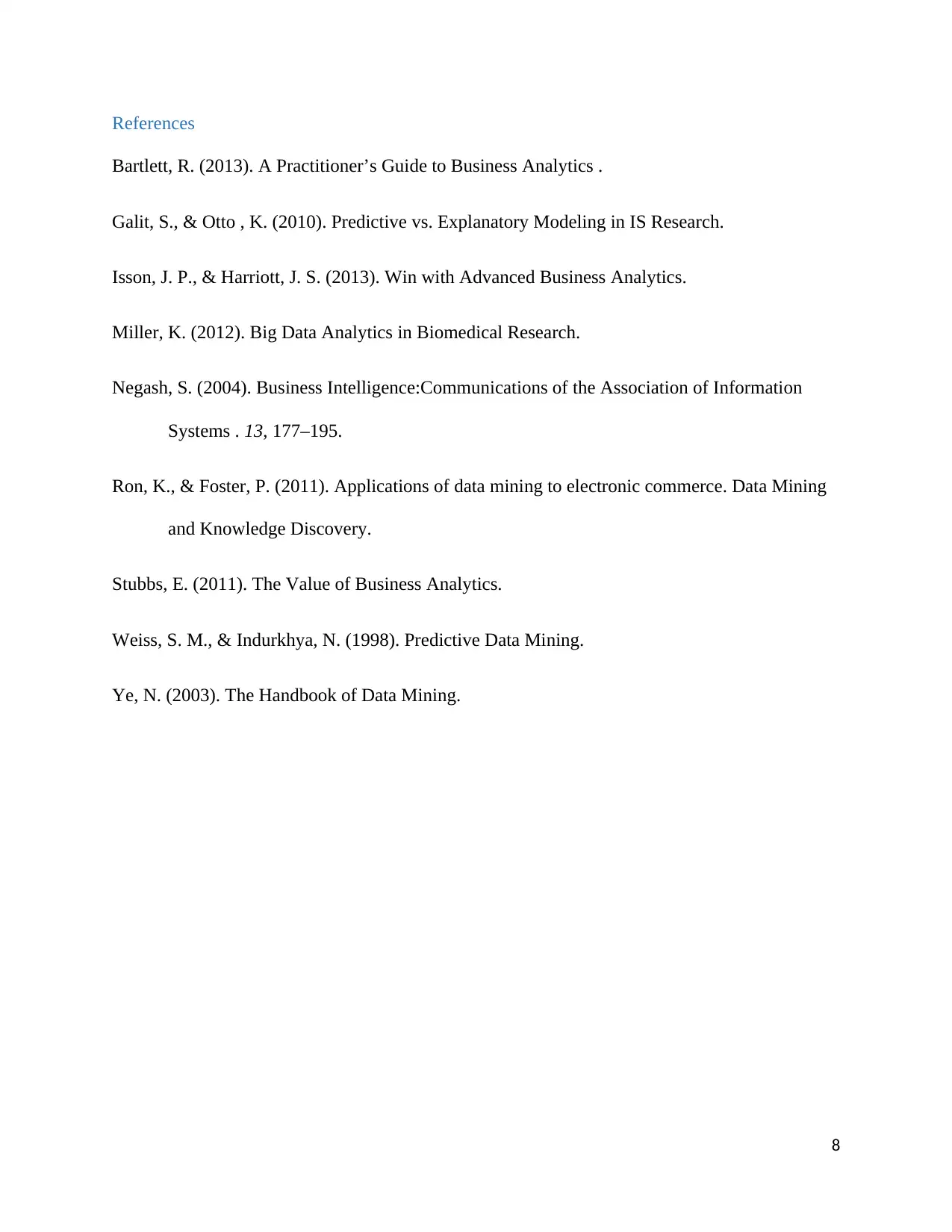
References
Bartlett, R. (2013). A Practitioner’s Guide to Business Analytics .
Galit, S., & Otto , K. (2010). Predictive vs. Explanatory Modeling in IS Research.
Isson, J. P., & Harriott, J. S. (2013). Win with Advanced Business Analytics.
Miller, K. (2012). Big Data Analytics in Biomedical Research.
Negash, S. (2004). Business Intelligence:Communications of the Association of Information
Systems . 13, 177–195.
Ron, K., & Foster, P. (2011). Applications of data mining to electronic commerce. Data Mining
and Knowledge Discovery.
Stubbs, E. (2011). The Value of Business Analytics.
Weiss, S. M., & Indurkhya, N. (1998). Predictive Data Mining.
Ye, N. (2003). The Handbook of Data Mining.
8
Bartlett, R. (2013). A Practitioner’s Guide to Business Analytics .
Galit, S., & Otto , K. (2010). Predictive vs. Explanatory Modeling in IS Research.
Isson, J. P., & Harriott, J. S. (2013). Win with Advanced Business Analytics.
Miller, K. (2012). Big Data Analytics in Biomedical Research.
Negash, S. (2004). Business Intelligence:Communications of the Association of Information
Systems . 13, 177–195.
Ron, K., & Foster, P. (2011). Applications of data mining to electronic commerce. Data Mining
and Knowledge Discovery.
Stubbs, E. (2011). The Value of Business Analytics.
Weiss, S. M., & Indurkhya, N. (1998). Predictive Data Mining.
Ye, N. (2003). The Handbook of Data Mining.
8
1 out of 8
Related Documents
Your All-in-One AI-Powered Toolkit for Academic Success.
+13062052269
info@desklib.com
Available 24*7 on WhatsApp / Email
![[object Object]](/_next/static/media/star-bottom.7253800d.svg)
Unlock your academic potential
Copyright © 2020–2025 A2Z Services. All Rights Reserved. Developed and managed by ZUCOL.




